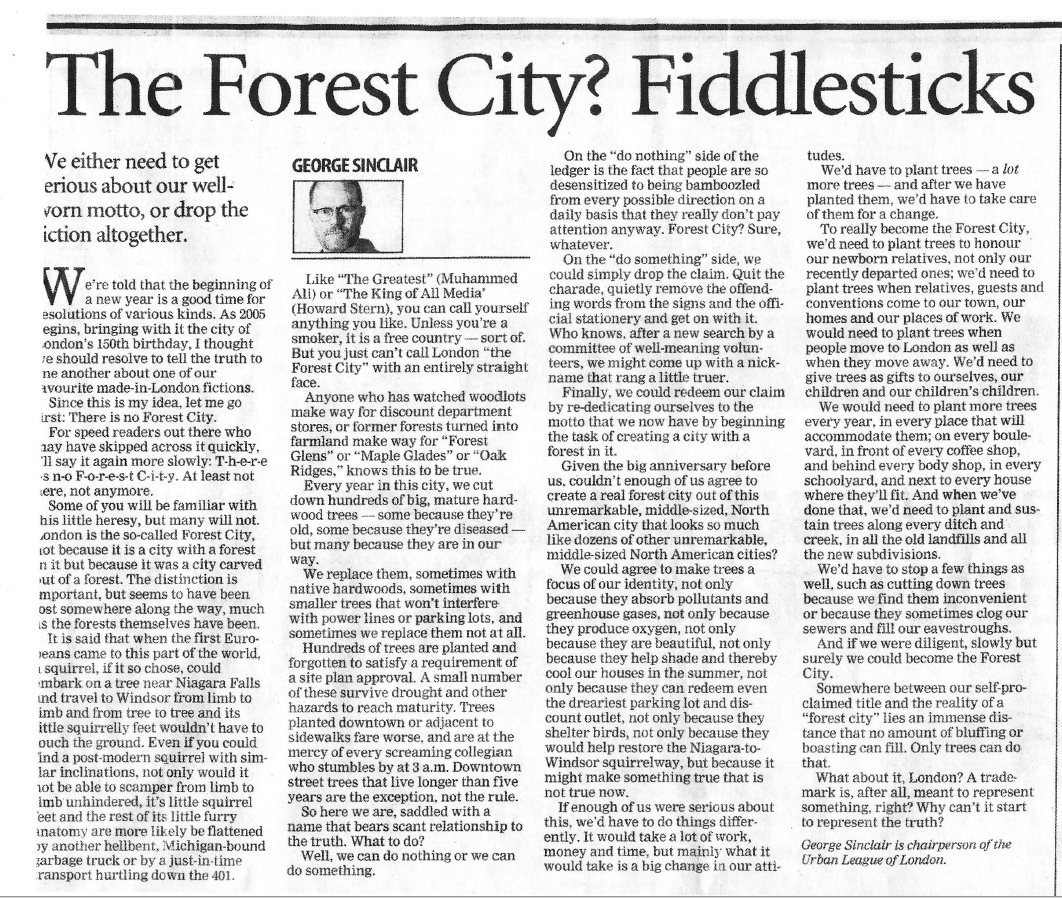Urban League Archives: Putting Trees Back in the Forest City
The Urban League’s Archives blog series was written by Heather Ellis. Heather Ellis is a local researcher in Southwestern Ontario. She is currently a PhD Candidate at Western University and teaches for the Thames Valley District School Board. Heather's current project explores the lives of London's veterans at Westminster Hospital in the early twentieth century.
---
In this final blog post of the series, I want to highlight the early years of ReForest London and how the Urban League of London, a strong advocate for quality natural areas and trees as part of its environmental agenda, incubated this new organisation.
In 2004 several large trees were demolished within the city, which directly contradicted the city’s motto: The Forest City. London’s overall green space only constituted 12% of the city’s physical space. Experts recommended a healthy ecosystem in a city should be approximately 30%-40% green space.[1] In an impassioned letter to the London Free Press, Urban League President, George Sinclair lamented this fact. He challenged Londoners to:
make trees a focus of our identity, not only because they absorb pollutants and greenhouse gases, not only because they produce oxygen, not only because they are beautiful, not only because they help shade and thereby cool our houses in the summer, not only because they can redeem even the dreariest parking lot and discount outlet, not only because they shelter birds, not only because they would help restore the Niagara-to-Windsor squirrelway, but because it might make something true that is not true now.[2]
The Urban League quickly launched the ‘StraTreegic Plan’, which sought to increase tree and woodland cover across the city. Although the Urban League participated in several environmental projects prior to ReForest London, this campaign was its largest undertaking. ReForest London received several large grants and donations which allowed ReForest London to rapidly grow.
To encourage community groups to take part, ReForest London matched the money raised by London’s communities. Their overall vision was to improve London’s environmental health by planting trees in the community – along streets, in backyards, in parks, and in natural areas – and provide expertise and funding for groups to plant trees in their own neighbourhoods. The trees also came with adoption papers, to highlight the community responsibility to these trees and ReForest London also checked on the trees the spring after they were planted.[3] By the end of 2004, ReForest London planted 61 trees at York and Adelaide. In the summer of 2005, ReForest London held several planting days. The most successful was Gibbon’s Park Community Planting Event, where 150 new shrubs and three large trees were planted.
ReForest London continued to plant trees across the Forest City from 2004-2006. The organization continued to grow and became a separately incorporated environmental charity in 2005. In 2011, ReForest London launched London’s Million Tree Challenge, which has inspired and supported individuals, businesses and institutions in planting over 475,000 trees in London so far. To learn more about ReForest London, visit their website here.
London now has a tree canopy coverage rate of 24% (as of 2015). The City has an Urban Forestry Management Strategy, with a target of 34% tree canopy coverage by 2065. This target will rely heavily on individuals and businesses since the City and ReForest London have planted trees on almost all the available public land.
______________________________________________________
[1] ReForest London Marketing and Communications Strategy, Box 10, File 9, p. 100
[2] “The Forest City? Fiddlesticks” George Sinclair, London Free Press, Box 10, File 6, p. 26.
[3] “Re-leaf is on the Way!” reForest City Project, Public Service Announcement, Box 10, File 6, p. 56.

